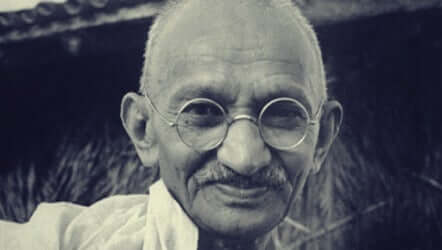The legacy of Mahatma Gandhi’s biography, whose real name is Mohandas K. Gandhi, still survives among us. He was the man who, with his humility, wanted to start a peaceful revolution to defend his country’s civil rights.
He rose up as a political and spiritual leader capable of inspiring much more than an entire country, while his vigilance and nonviolent disobedience conquered the whole world.
- October 2nd celebrates the day of non-violence.
- That’s when we have to think about what the leader of Indian independence left us in the middle of the twentieth century.
In addition to his political and social goals, what Gandhi offered for our contemporary history was a style of thought, a philosophy of life.
During his nearly three decades of peaceful activism, he not only wanted to free his people from the British Raj, but their goals were higher.
He defended social justice, aspired to the transformation of economic structures and laid the foundations for a more active human ethic, taught us that harmony between religions may be possible between different peoples.
Mohandas K. Gandhi was born in Porbandar in 1869 and belonged to a different caste than India in the late 19th century.
His father was the prime minister of Gujarat and his mother, practitioner of Hinduism, was a woman who distinguished he himself by her tolerance and by the defense of peaceful coexistence between all religions.
He grew up in a privileged environment in all aspects, for the economic well-being, harmony and spirituality that, from an early age, was instilled in him in almost every way, was vegetarian, fasted and was very attached to all the traditional knowledge of his country. Culture.
However, his family chose him, among his two older brothers, to improve his academic career. He was therefore sent to London in 1888 to study law.
This phase of his life outside India lasted nearly two decades and was crucial in building his identity, social activism and philosophical belief.
In England, he had contact with the circle of theophos who initiated him in the Bahagavad Gita, the sacred book of Hindus, which decisively inspired him in his religious ideals and principles.
After graduating, the in-experience lawyer traveled to South Africa, a divided and unstable country in several colonies ruled by the British and Dutch.
It was in this context that he began a decisive stage in his life, in which the young lawyer suddenly became a strong advocate of equality and freedom.
It was in South Africa that these four characteristics were developed that defined Mahatma Gandhi:
When Gandhi returned to his country in 1915, things had gotten worse in India. A law was about to be passed to ban Hindu suffrage.
It was at this time that he began to apply the same social activism that had already begun in South Africa: he called his people to the resistance and the Satyagraha (the creed of non-violence).
The world, in turn, echoed World War I and began to lay the foundations for India’s peaceful independence. To do this, he has used a tactical and intellectual approach that has been as innovative as it has been inspiring for several generations.
Mahatma Gandhi set up a farm in the city of Ahmedabad to gather his disciples, became a spiritual leader who inspired many communities, gradually appearing more peaceful colonies, which in turn ignited the engines of a great revolution.
An effective strategy is to stop cotton production, an essential part of the British textile industry, and then do the same with the British salt monopoly.
Campaigns of civil disobedience have cost him and his people thousands of lives for several years in prison, however, the goal was achieved: India’s independence as a British colony came on 18 August 1947.
A few months later, on January 30, 1948, Gandhi was killed by Hindu extremist Nathuram V. Godse in the middle of a crowd. He was 78.
Satyagraha was a word coined by Gandhi himself to represent his struggle, which was based on this strong resistance that was not about resorting to violence.
Thus, this humble and stubborn man for the defense of social rights (to the point of being nominated five times for the Nobel Peace Prize) insisted that life is indivisible and, as such, it is inconceivable that one person could cause harm to another.
Therefore, all active struggle for the good and defense of the sick must be based on satyagraha, a dimension that includes the following principles:
Gandhi developed an undeniable change of thought in the 20th century, leaving an inspiring mark, as Martin Luther King did in his day or Mandela himself years later.
These kinds of inheritances are certainly a challenge for our time, taking your example and learning from these numbers is something we should all think about to improve the course of our civilization.
“The most appalling thing about the wrong people is the silence of the right people. “Gandhi

